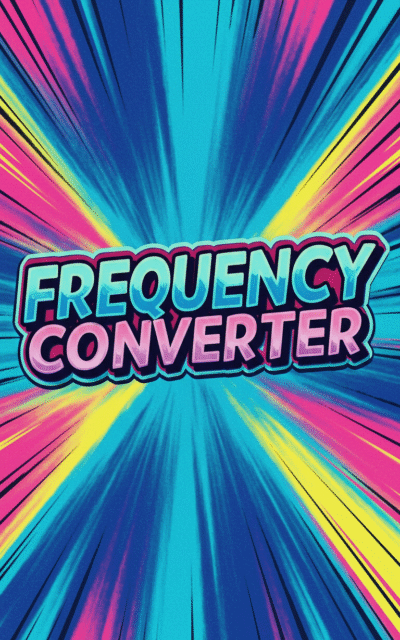Frequency Converter
Convert between Hz, kHz, MHz, GHz, THz, RPM, BPM, rad/s, and °/s with our free frequency converter. Simple, accurate calculations for engineers and professionals.
Guide
What is a Frequency Converter?
A frequency converter is a digital tool that allows you to convert between different frequency units quickly and accurately. This tool supports conversions between standard frequency measurements such as Hertz (Hz), Kilohertz (kHz), Megahertz (MHz), Gigahertz (GHz), Terahertz (THz), and related angular measurements like Rotations per Minute (RPM), Beats per Minute (BPM), Radians per Second (rad/s), and Degrees per Second (°/s).
Key Features
- Two-Unit Mode: Convert directly between any two frequency units
- All Units Mode: Enter a value in one unit and see conversions to all other supported units simultaneously
- Real-time Calculation: Results update automatically as you type
- Formula Display: Shows the mathematical relationship between units for educational purposes
- Mobile-Friendly: Responsive design works on all devices
Supported Frequency Units
| Unit | Symbol | Description |
| Hertz | Hz | The SI unit of frequency defined as one cycle per second |
| Kilohertz | kHz | Equal to 1,000 Hertz |
| Megahertz | MHz | Equal to 1,000,000 Hertz |
| Gigahertz | GHz | Equal to 1,000,000,000 Hertz |
| Terahertz | THz | Equal to 1,000,000,000,000 Hertz |
| Rotations per Minute | RPM | Number of complete rotations in one minute |
| Beats per Minute | BPM | Number of regular events in one minute, commonly used in music |
| Radians per Second | rad/s | Angular frequency measurement in the SI system |
| Degrees per Second | °/s | Angular frequency measured in degrees |
When to Use a Frequency Converter
- Electronics: Converting between Hz, kHz, MHz, and GHz when working with electronic signals
- Telecommunications: Converting frequency bands for various communication systems
- Audio Engineering: Working with audio frequencies across different scales
- Physics Applications: Converting between rotational and linear frequency measures
- Engineering Design: Calculating appropriate frequencies for motors, oscillators, or other rotating equipment
- Music Production: Converting between BPM and Hz for synthesizer settings
How to Use This Frequency Converter
- Select either “Two-Unit” or “All Units” mode based on your needs
- In Two-Unit mode, enter a value in either input field
- Select the appropriate units from the dropdown menus
- View the converted result in the other field
- In All Units mode, enter a value in any field to see all conversions
- Note the formula shown for educational purposes
Common Frequency Conversion Formulas
- 1 kHz = 1,000 Hz
- 1 MHz = 1,000,000 Hz
- 1 GHz = 1,000,000,000 Hz
- 1 THz = 1,000,000,000,000 Hz
- RPM to Hz: Hz = RPM ÷ 60
- Hz to RPM: RPM = Hz × 60
- rad/s to Hz: Hz = rad/s ÷ (2π)
- °/s to Hz: Hz = °/s ÷ 360
Practical Applications
Frequency converters are essential in many fields including telecommunications, electrical engineering, audio production, and scientific research. Whether you’re designing electronic circuits, calibrating equipment, or working with rotating machinery, this converter helps ensure accurate translations between different frequency units.
FAQ
-
How do I convert Hz to MHz?
To convert Hertz (Hz) to Megahertz (MHz), divide the frequency value by 1,000,000. For example, 5,000,000 Hz equals 5 MHz. You can use our frequency converter tool by entering the value in Hz and selecting MHz as the target unit for instant conversion.
-
What's the difference between Hz and RPM?
Hertz (Hz) measures the number of cycles per second, while Rotations Per Minute (RPM) counts complete rotations in one minute. To convert between them: 1 Hz = 60 RPM, because there are 60 seconds in a minute. For example, a motor running at 3,000 RPM is operating at 50 Hz.
-
How are BPM and Hz related in music production?
BPM (Beats Per Minute) and Hz (Hertz) serve different purposes in music. BPM measures tempo, while Hz measures sound frequency (pitch). They're related in synthesizer settings, where certain effects need to be synchronized with the beat. The conversion is similar to Hz-RPM: 1 Hz = 60 BPM.
-
Why would I need to convert between frequency units?
Converting between frequency units is necessary when working across different systems or specifications. Engineers might receive specifications in MHz but need to work in GHz, or audio professionals might need to synchronize equipment using different units. Scientists often need to convert between angular frequencies (rad/s) and linear frequencies (Hz) when analyzing rotating systems.
-
What is the relationship between angular frequency (rad/s) and Hz?
Angular frequency measured in radians per second (rad/s) is related to frequency in Hertz by the formula: f(Hz) = ω(rad/s) ÷ 2π. This is because one complete cycle (2π radians) per second equals 1 Hz. For example, an angular frequency of 6.28 rad/s (approximately 2π) equals 1 Hz.
-
Can frequency conversions help in tuning musical instruments?
Yes, frequency conversions are useful for tuning instruments. Musicians often work with specific frequencies for notes (like A4 = 440 Hz). When using electronic tuners that may display in different units or when tuning to different standards, understanding how to convert between frequency values ensures accurate tuning across different systems and references.
-
What does the THz frequency range represent?
Terahertz (THz) frequencies, ranging from 0.1 to 10 THz, fall between microwave and infrared regions of the electromagnetic spectrum. This range has unique applications in imaging, security scanning, telecommunications, and spectroscopy. THz waves can penetrate many non-metallic materials but are non-ionizing, making them safer than X-rays for certain scanning applications.
Install Our Extensions
Add IO tools to your favorite browser for instant access and faster searching
Must-Try Tools
View All New Arrivals
View AllUpdate: Our latest tool was added on Sep 23, 2025

